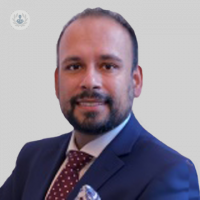How successful is DMEK eye surgery?
Escrito por:DMEK (descemet membrane endothelial keratoplasty) is a state-of-the-art partial-thickness corneal transplant procedure that replaces only the eye’s damaged Descemet membrane and endothelium (the inner lining of the cornea), without harming healthy cells.
Here, Mr Maninder Bhogal, renowned consultant ophthalmologist based in London, provides an expert insight into DMEK eye surgery.

What is DMEK eye surgery?
The cornea is a clear window on the front of our eye that acts as a lens to focus light. The inner lining of the cornea is called the endothelium, and this is responsible for keeping the cornea clear.
In some patients, however, the corneal endothelium stops working, and the cornea becomes water-logged and cloudy. The commonest reasons for this are:
- An inherited weakness of the corneal cells called Fuchs’ dystrophy
- Complications following previous surgery
Additionally, the endothelium may stop working:
- After viral infections
- In patients who have glaucoma
- In patients who have had previous corneal transplants
We are born with all the endothelial cells we need to last our lifetime, and the endothelium cannot replicate. If it is damaged, the only thing that can be done, as of now, is to replace the endothelium. In the past, replacing the damaged endothelium meant replacing the whole cornea with a procedure called penetrating or full-thickness transplant.
In the last two decades, however, there have been great strides in corneal transplant surgery, and now we can selectively replace the endothelial cells without removing the other healthy layers of the cornea. This new procedure is called DMEK. The eye is stronger, the vision is better, and the vision recovers quicker following DMEK surgery compared to full-thickness corneal transplantation.
The long-term risks following transplantation, such as rejection of the graft and glaucoma, are also much lower with DMEK surgery compared to penetrating or full-thickness transplantation.
How is DMEK performed?
In DMEK, a healthy layer of endothelial cells are prepared from a donor cornea. These are then injected into the eye and held in place with a bubble of gas. The procedure is usually performed as a day-case, and patients do not need to stay in hospital. It can also be performed while the patient is awake, after numbing the eye with some anaesthetic.
The gas bubble instilled at the end of the operation will hold the new cells in place until they start to work, by which time the new transplant is firmly attached to the cornea. Following the surgery, patients will need to try and lie flat for as much as possible for two days, as this helps the graft stick and recover quickly. Patients can get up to eat, drink, and shower.
How long does the procedure take?
DMEK surgery is similar to other types of eye procedures, such as cataract surgery.
It takes around 30 minutes for a straightforward DMEK in a patient who has Fuchs’ dystrophy, although the DMEK surgery may be combined with cataract surgery or other procedures if necessary. In patients who have more complex eye problems, additional surgical steps are usually necessary, and this adds further time.
After surgery, I ask my patients to lie flat for an hour and then I check that the gas bubble has a perfect pressure, making adjustments if necessary.
How long does a DMEK transplant last, and should patients get check-ups?
DMEK surgery in patients who have Fuchs’ dystrophy can restore vision in a matter of a week and then go on to last decades.
It is important to check that everything is working well following the transplant and that patients are not developing any side effects from drops. For this reason, I see my patients every week for the first two weeks following DMEK. If all is well, the appointments can be spaced out, moving to monthly, three monthly, and then once every six months.
Patients will need to take anti-inflammatory drops every few hours after the initial DMEK surgery, and these are gradually reduced down over the course of about three months to one drop a day. I may also ask patients to stay on a single drop of anti-inflammatory medication thereafter.
What is the success rate of DMEK surgery?
Improving outcomes with DMEK was the focus of my PhD thesis, and many of the refinements to the DMEK procedure I have developed have been adopted both in the UK and internationally. The results of my techniques for DMEK are some of the best in the world and my success rate is over 99 per cent in patients who have Fuchs’ dystrophy.
The commonest problem following DMEK is needing a second air bubble, and fewer than 1 in 20 of my patients will need a second air bubble following the procedure. This compares very favourably to about 1 in 4 patients needing a second air bubble in other surgeons’ hands.
I also perform DMEK in very complicated eyes, where many other surgeons who lack experience in this technique would prefer to perform a full-thickness transplant instead. In these cases, the risk of needing a second gas bubble is higher, but the benefits of DMEK are so overwhelming that performing DMEK would still be my preferred choice.
I regularly publish research on DMEK, and currently I am looking at ways to customise the graft to individual patients. I additionally teach DMEK surgery all over the world, and I am a faculty member of the Endothelial Keratoplasty Learners Group that has helped teach over 2,000 eye surgeons DMEK surgery and other forms of endothelial replacement therapy.
If you need DMEK surgery, you can be in no safer hands, and I look forward to using my expertise and experience to help you through this process.
Mr Maninder Bhogal is an award-winning consultant ophthalmologist with over 15 years’ experience.
If you require or are considering DMEK eye surgery, don’t hesitate to book an appointment with Mr Bhogal via his Top Doctors profile today.


